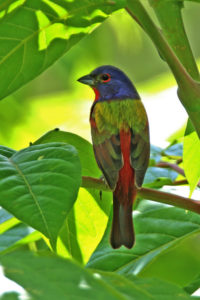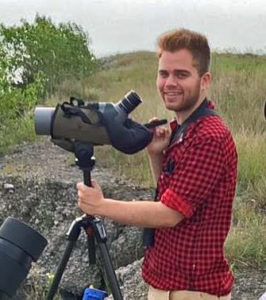By Aaron Gyllenhaal, as told to Ted Wolff
The first thing I saw was a bird flying over me with a bright red belly. I got my binoculars on it and saw it land. The next thing I saw was a blue head and a green back, which is when I freaked out.
I went from confused to surprised to floored in what seemed like a second. It was an emotional roller coaster. I had trouble getting out an intelligible sentence because I was stunned. Luckily, I was able to get Ted Wolff on the bird, and only then was I able to take in what I was looking at. My heart was pounding in my chest while I was staring at this beautiful bird that I had hoped, but did not expect, to see. My breathing bordered on hyperventilation, but somehow I had the sense to snap a few pictures to confirm the sighting. That reflex proved to be unnecessary, however, because the bunting flew from the dense cottonwood tree above us to an exposed power line, where it perched in full view, singing for nearly ten minutes. I was in a state of euphoria watching this bird.
The moment I rediscovered the bunting is one that will be etched in my mind forever.
Background

I should provide some background on the trip to East St. Louis, and the sighting of the Painted Bunting on May 29, 2016.
I actually had this bird on my state list for a few years. Early in my birding career my family stopped at Front Street in East St. Louis during our vacation. We heard a distant Painted Bunting singing, but never saw it. At the time I decided that was enough to count it. While going through my state list a few years ago, I chose to remove the Painted Bunting because, while I heard what I thought was its song, I was not sure I could eliminate other similar songs due to my lack of experience. Thus Painted Bunting became one of my biggest nemesis birds. The number of sightings in surrounding states, combined with the lack of sightings in Illinois, began to annoy me, so I decided to check the place most likely to have them.
I was not convinced they were still around. In fact, I was convinced that the buntings left years ago. However, this is the only place in Illinois where they were reliable at in the past, so I figured it would be the best place to start looking for them.
The last sighting I can remember of Painted Bunting in the state was in Iroquois County, in 2012, and I believe that bird was on private property. The last sighting in East St. Louis was in 2011, about a mile south of where we re-found the bird. I chased the 2011 bird, but my dad and I struck out. I believe the last time that breeding was confirmed along Front Street was 2008.
Research
I wanted to do more than drive to Front Street and start looking, so I did some research. My two main sources of information were the IBET archives and eBird. Together these made me confident that I had not missed any reports. I then messaged the people that seemed to have the most experience in finding the buntings for advice on where to look. A few years prior, when my dad and I tried for the bunting to no avail, I had messaged multiple southern Illinois birders. I therefore knew that Dan Kassebaum and Keith McMullen would be the most likely to help, both because of their general birding knowledge, their specific knowledge of the Metro St. Louis area, and also because of their generous spirits; it seems like they are always willing to share their knowledge and help out other birders. Dan has been checking for the buntings multiple times every year, so he was able to give me as much information as I needed.
Memorial Day birding trip
I got in touch with Ted Wolff, with whom I have had good luck chasing birds, from our first trips in 2013 for a Harlequin Duck at 63rd Street in Chicago and the Spotted Redshank at Goose Pond, Indiana, which was our first long-distance trip,
This trip had a major, but not a single, focus. We hoped to see a number of rarities, knowing full well we had little to no chance of getting some, but if you don’t look you definitely won’t see!
The bird we thought we had the best chance of getting was a Brown Pelican that had been seen at Melvin Price Lock and Dam in Alton, on the Mississippi River, but unfortunately it has not been reported for a week prior to the trip. We went there first on Saturday afternoon, May 28, and missed it. We went back Saturday evening, and again Sunday morning before seeing the Painted Bunting, but we missed it every time.
Other target birds included White-winged Dove (reported outside of Springfield the day before we left), Western Kingbird, Scissor-tailed Flycatcher, Black Rail (the unlikeliest of them all), and more southern Illinois specialties.
Ted picked me up early in the morning, and we left Oak Park and headed for the White-winged Dove spot in Menard County, where we ran into Phil Doncheck and enjoyed the hospitality of the birder and homeowner, and passed a pleasant hour on his deck looking at the feeders, but without seeing the dove. We left for East St. Louis, and just past Lake Springfield I saw a report on IBET of Black-bellied Whistling-Ducks at Lake Springfield. We turned around, got to the lake, and quickly found the group of ducks on the far bank, near the power plant, in the shade of some trees.
We then continued to Alton, where we failed to refind the Brown Pelican early Saturday afternoon; headed to Front Street in East St. Louis, where we dipped on the bunting; and then back late Saturday afternoon for another miss on the pelican. We went one last time early Sunday morning, hoping to get there before the fishermen showed up and disturbed the bird, but again there was no pelican.
After dipping for the last time we headed to Front Street in East St. Louis where this time, after an hour of viewing and listening, we first saw the Painted Bunting singing and giving great looks on the power line near the Illinois American Water Company facility.
Mission accomplished!
After I calmed down I texted a few of my birding buddies to let them know that the bird had been refound, and we decided to continue our trip to southern Illinois for the other specialties.
The rest of the trip
We headed south, and after just a few miles we saw Black-Necked Stilts in a roadside wetland. Ted stopped the car, backed up, and we got the stilts in view on the far side of the wetland. Then I looked down on the near bank and there, partially hidden by the vegetation, was a group of three Black-bellied Whistling-Ducks! It’s always great to see an uncommon species, but it’s so much sweeter to discover the bird on your own. This was icing on the cake of an already great morning. I texted Keith McMullen, who lives nearby in Fallon, as I was sure he’d rather drive for fifteen minutes to see the ducks than drive all the way to Lake Springfield.
Other good birds on the trip included Western Kingbird at the casino in E. St. Louis and at the substation outside Havana, the Whimbrel found by Kevin Richmond, also outside Havana, Scissor-tailed Flycatcher, King Rail, and Least Tern.
Birds we missed were the Brown Pelican, Black Rail, Upland Sandpiper, Glossy Ibis, White-faced Ibis, and Western Sandpiper.
A little bit about me

I used to be a lot bigger on chasing than I am now. Now most of my birding time is spent at the former US Steel South Works property on the south side of Chicago, which I call the “87th Street steel mills.” This includes Steelworker’s Park and Park 566.
The only potential target birding I currently have in mind is a hunt in southern Illinois this winter for a Great-tailed Grackle. I don’t have any other specific birding plans at the moment, but I can never turn down a good trip.
I am going into the second semester of my sophomore year at Illinois State University. I have settled on public relations as my major with a minor in math and business analytics. Beyond that, my interests mainly lie in music and birds. I hope to have an internship this summer at a public relations agency and continue working at Wonder Works Children’s Museum in Oak Park. However, I always find time to go birding, mainly because my sanity requires it.
